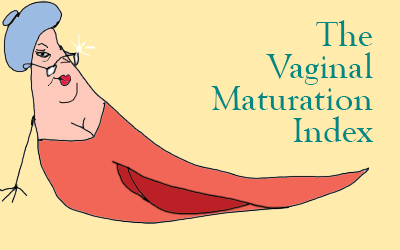When people think about menopause, they typically think about hot flashes and night sweats. While these things are very common during the transition period into menopause, they normally subside over time. However, low estrogen levels can also cause long-term consequences like vaginal dryness and vulvovaginal atrophy. These symptoms have a significant negative impact on a woman’s quality of life.
The Genitourinary Syndrome of Menopause
The terms vaginal dryness and vulvovaginal atrophy don’t fully describe the changes in female genital function and anatomy after menopause. In 2014, the Board of Directors of the International Society for the Study of Women’s Sexual Health (ISSWSH) and the Board of the North American Menopause Society (NAMS) approved a new term “the genitourinary syndrome of menopause” (GSM) to describe these changes.1 The genitourinary syndrome of menopause describes the various changes to the lower urinary tract, vulva, and vagina after menopause. Low estrogen can lead to urinary symptoms like the feeling of urgency to urinate, pain with urination, and greater susceptibility to urinary tract infections (UTI). In addition, women can experience genital dryness, itching, burning, and irritation. These can lead to sexual symptoms like decreased or lack of lubrication, pain with sex, and other sexual dysfunction.
The Impact of Estrogen
Estrogen promotes the proliferation of stratified squamous epithelial cells, which line the vaginal mucosa. With premenopausal levels of estrogen, the epithelial layer is thicker and more resilient. When estrogen decreases, the epithelial layer becomes thinner and more fragile. The epithelial cells are important because they form the barrier of the vagina, but they also produce glycogen and amylase, which feed the lactobacilli species of bacteria.2 In premenopausal women, Lactobacillus spp. are the predominant bacterial species in the vagina, although there are racial variations, and they are associated with vaginal health.3 Most lactobacilli produce lactic acid, causing an acidic environment and preventing other, less beneficial bacterial species from taking hold. Typically, as estrogen decreases, the amount of Lactobacillus spp. in the vagina decreases. Fewer lactobacilli mean decreased lactic acid, and consequently the pH rises. A more alkaline environment allows other less beneficial bacteria to become established, contributing to vaginal infections, irritation and even urinary tract infections.2
What to do about GSM?
About 45-63% of postmenopausal women experience GSM1. The “impact of vaginal dryness on interpersonal relationships, quality of life, daily activities, and sexual function can be significant.”4 Women often view these symptoms as an unavoidable part of aging and don’t report them. This means that that GSM often goes untreated.2 However, there are a many ways to manage these symptoms. The standard approach is to use vaginal moisturizers and lubricants.5 For many women, these treatments are very effective and all that is required.
Another option for more persistent symptoms is locally applied vaginal estrogen. Studies have shown that vaginal estrogen improves both vaginal and urinary symptoms, and it also appears to positively impact the vaginal microbiome as well.1,6 While this low-dose, local estrogen therapy is generally considered safe, it may be contraindicated in women with or at increased-risk of estrogen-dependent tumors.5
Other potential treatment options include selective estrogen receptor modulators (SERM) and natural products that have phytoestrogens like sea buckthorn oil and soy isoflavones.7 Because the vaginal microbiome plays such an important role for vaginal health, probiotics and prebiotics provide another potential therapy, although this concept is relatively new.6
This is by no means an exhaustive list of the treatments for GSM, but it is meant to be a glimpse at options for women who might be suffering while thinking that their symptoms are an inevitable part of aging. All these treatment options deserve a closer look and will be the subjects of upcoming blog posts.
Questions about Menopause?
Do you have questions about menopause? The Office on Women’s Health has a resource page with basic information about menopause.
REFERENCES:
1. Kim H-K, Kang S-Y, Chung Y-J, Kim J-H, Kim M-R. The Recent Review of the Genitourinary Syndrome of Menopause. J Menopausal Med. 2015;21(2):65. doi:10.6118/jmm.2015.21.2.65
2. KelloggSpadt S. Vulvovaginal Atrophy. Adv Nurse Pract. 2010;18(4):31-32,34,55. doi:http://dx.doi.org/10.1016/j.juro.2011.02.2689
3. Brotman RM, Shardell MD, Gajer P, et al. Association between the vaginal microbiota, menopause status and signs of vulvovaginal atrophy. 2015;21(5):450-458. doi:10.1097/GME.0b013e3182a4690b.Association
4. Edwards D, Panay N. Treating vulvovaginal atrophy/genitourinary syndrome of menopause: How important is vaginal lubricant and moisturizer composition? Climacteric. 2016;19(2):151-161. doi:10.3109/13697137.2015.1124259
5. Francis D Sheski M. Official reprint from UpToDate ® www.uptodate.com ©2018 UpToDate, Inc. and/or its affiliates. All Rights Reserved.Medical thoracoscopy :Equipment, procedure, and complications. 2018:17-19. doi:10.1007/s11920-014-0463-y
6. Muhleisen AL, Herbst-Kralovetz MM. Menopause and the vaginal microbiome. Maturitas. 2016;91(2016):42-50. doi:10.1016/j.maturitas.2016.05.015
7. Lee A, Kim TH, Lee HH, et al. Therapeutic Approaches to Atrophic Vaginitis in Postmenopausal Women: A Systematic Review with a Network Meta-analysis of Randomized Controlled Trials. J Menopausal Med. 2018;24(1):1. doi:10.6118/jmm.2018.24.1.1
